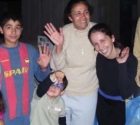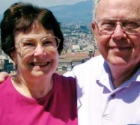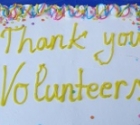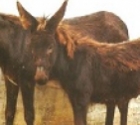
When Ora Ron was a carefree child growing up in her Jezreel valley kibbutz,the Arab neighbors lived only a short walk away – a very short walk away in fact.
Standing with Ora on the outer lip of the kibbutz where she has lived all her life – and where I have spent the last forty years of mine – the well-known seventy-something Israeli artist points to a chicken coop atop a small hill on the other side of a none too deep ravine that, during the winter months, sometimes sees runoff from the Menashe hills behind which it trickles through.
Not exactly a moat around one’s castle, but the small ravine did define the border of the kibbutz in pre-State days.
“Can you believe that just over there was an Arab village?” she asks me in a tone implying that she almost doesn’t believe it herself.
It is even harder to believe that during the War of Independence a heavily armed Arab army known as the Arab liberation army under the command of Fawzi al-Kaukji sat perched on the same hilltop, intent upon conquering Mishmar HaEmek and then to do likewise with the port town of Haifa.
Two infantry battalions and nine artillery units gathered in the Menashe hills waiting for the order to begin their attack.
The local Arab population from the villages surrounding Mishmar Ha Emek headed not only for the higher hills to avoid the fighting,but most ended up in the refugee camp of the nowadays autonomous Palestinian city of Jenin, tucked away in the corner of the Jezreel valley, a mere fifteen minute drive away.
Apart from firearms, al-Kaukji’s forces also had Syrian provided mortars, shelling from which caused heavy casualties amongst the Jewish fighters, destroyed many of the kibbutz buildings – including the high-school dormitories – and almost wiped out the dairy herd.
The Arab commander decided to attack the kibbutz on April 4, 1948 knowing that a large part of the Jewish forces were elsewhere, attempting to release the siege on Jerusalem. The bitter battle for Mishmar HaEmek lasted for eight long days and nights. With the kibbutzniks’ ammunition supply dwindling and casualties mounting the situation was grim but they were buoyed up by the success of small planes managing to drop supplies to the beleaguered kibbutz men and women manning the defenses.
Following some days of fighting, a 24 hour ceasefire was secured by a British officer and during the lull in hostilities the kibbutz children and the wounded were evacuated and Haganah reinforcements managed to slip in to aid the locals. Fighting restarted with a vengeance and eventually al-Kaukji’s forces were isolated and they finally retreated.
Together with a handful of fellow members of kibbutz Mishmar Ha Emek, Ora Ron was instrumental in setting up an in-house museum to document – with photographs, film and exhibitions of artifacts from yesteryear – the rich history of – Mishmar Ha Emek, founded in the 1920s, one of the flagship kibbutzim of the Hashomer Hatzair movement.
The building chosen for the museum is in itself an integral part of the history of the community, situated on the western rim of the Jezreel valley and hugging the slopes of the expansive Menashe range of hills. Standing only meters away from the shallow ravine, the small concrete building comprises two floors and is known as the emda (guard post) – which it literally was during the heavy fighting around the kibbutz sixty years ago.
Built in 1928 to house a pump, drawing water from a nearby well dug by the members the previous year, the building was used for some years to store eggs from the kibbutz poultry farm and the ground floor was used as a small winery. A pit was dug under the building to conceal arms from the British Mandate soldiers and from police who would conduct searches of the kibbutzim from time to time.The top floor of the former guard post contains a model of the kibbutz as it was in the 1930s – tents, wooden huts and a large silo. Sepia photographs on the walls show the Zionist movement kibbutz pioneers of yore hard at work building their community, roads, forests and a future state.
One portion of the wall is taken up with small arms. Neatly stacked underneath are tin plates, cups and cooking utensils which were found way back in the communal kitchen. A number of kerosene lamps are also on display. They would have shone light on the weary workers as they gathered of an evening in the dining-room to discuss the work roster for the following day, collectively make decisions with regard to education, health, security and a myriad of other issues to be dealt with – and listen to the only radio in the community at the time.
The bottom floor of the former guard post deals with the War of Independence and the two major attacks on the kibbutz in April 1948 and also with the attack during Chanukah the same year. During a blackout the kibbutz was bombarded by Iraqi planes trying to destroy the Ramat David air base in the valley. A chink in one of the blackout curtains had enabled a pilot to see the burning candles of a chanukiah in one of the children’s houses and, thinking it was the airbase, he had released the bombs. Three of the nine-year-old children sleeping in the 1930 built concrete house died in the attack as well as a female member of the kibbutz.
Thirty years later, Ora Ron created a decorative chanukiah spinning top in memory of the kibbutz children who were killed in 1948 and who were destined to celebrate their last lighting of the chanukiah.
Today, children climb over and play inside the gigantic hollow spinning top embedded in the roof of a disused underground air-raid shelter close to the spot where the bombed children’s house –had been.
When the building became dilapidated there were plans to raze it and build in its place a block of offices for the kibbutz administration. However, a group of kibbutz members, including Ora Ron, formed an ad hoc committee to save the building. Eventually it was totally renovated to accommodate offices and a memorial with the names of the victims of the Chanukah bombing raid was erected at the entrance.
Prior to 1948 Mishmar Ha Emek had been sandwiched between the Arab villages of Abu Shusha, Rubaya Tuchta and Rubaya Foca.
“As children we would often go and visit the local villages either with our teachers or parents”, reminisces Ora, standing outside the emda and glancing in the direction of what had been Rubaya Tuchta. Her Polish born father, Mordecai Bentov, had been a founding member of the kibbutz and a well-known politician from the Mapam party. Bentov was a signatory on the Declaration of the Establishment of the State of Israel and had served five terms in the Knesset, including stints as minister of development and minister of housing.
“My father believed we should learn Arabic and have a better understanding of the Arab culture so as to live together as good neighbors. He regularly visited the landowner’s overseer (known as the Bek) in the village of Rubaya Tuchta, just over the fence from us,” explained Ora. She remembers that the man spoke good English and lived in a stone house, while the rest of the people lived in small huts built from mud bricks.
“I even remember the days when we would go up to the kibbutz fence to exchange marbles with the Arab children – but that was then,” she added wistfully.
Prior to the War of Independence, Arab children would come on certain days of the week for sport and other joint activities together with their kibbutz peers. Two ardent photographers at that time, Yoel Lotan and Ora’s father Mordecai, took photographs of the children mixing together and playing matches on the sports ground. A number of those photographs are also displayed on the walls of the guard-post cum in-house museum.
Yoel Lotan was an accomplished film taker and maker. Film that he took of the heavy fighting around his home community in 1948 can be found in the Stephen Spielberg archives in America, the Jewish National Fund archives in Israel and also among the kibbutz’s extensive collection of memorabilia.
“In the films we see the Arab boys barefooted and wearing kefiyehs and the girls in dresses, while the kibbutz children are all wearing shorts and sandals,” laughs Ora.
“We certainly saw a different future for ourselves – and them – at that time,” she concludes.
 ESRA ASHKELON DONATED GOODS
ESRA ASHKELON DONATED GOODS  DEFIANCE TEL AVIV STYLE
DEFIANCE TEL AVIV STYLE  THE SPIRIT OF ESRA-JULES AND PERLA FOX- EXCEPTIONAL BENEFACTORS
THE SPIRIT OF ESRA-JULES AND PERLA FOX- EXCEPTIONAL BENEFACTORS A new website in English - on Volunteering - Launched in Israel
A new website in English - on Volunteering - Launched in Israel Help Needed for Abused Horses and Donkeys
Help Needed for Abused Horses and Donkeys Heather's Heseg
Heather's Heseg Lydia Aisenberg
Lydia Aisenberg